Anti Protozoal Agents Introduction
The antiprotozoal drug is any agent that kills or inhibits the growth of organisms known as protozoans. Protozoans cause a variety of diseases, including malaria and disease.
- While protozoans typically are microscopic, they are similar to plants and animals in that they are eukaryotes and thus have a clearly defined cell nucleus.
- This distinguishes them from prokaryotes, such as bacteria.
- As a result, many of the antibiotics that are effective in inhibiting bacteria are not active against protozoans.
Classification Of Antiprotozoal Drugs
Metronidazole: Metronidazole is one of the mainstay drugs for the treatment of anaerobic infections.
- It is approved by the US Food and Drug Administration for the treatment of anaerobic and protozoal infections.
- Metronidazole exerts its antimicrobial effects through the production of free radicals that are toxic to the microbe.
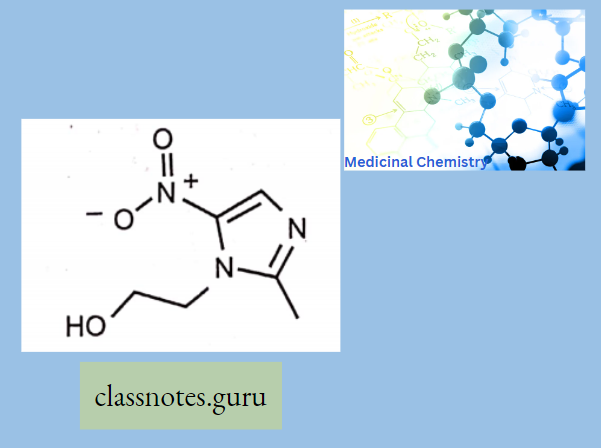
Mechanism Of Action: It inhibits nucleic acid synthesis by disrupting the DNA of microbial cells. This function only occurs when metronidazole is partially reduced, and because this reduction usually happens only in anaerobic bacteria and protozoans, it has relatively little effect on human cells or aerobic bacteria
Read and Learn More Medicinal Chemistry III Notes
Tinidazole:
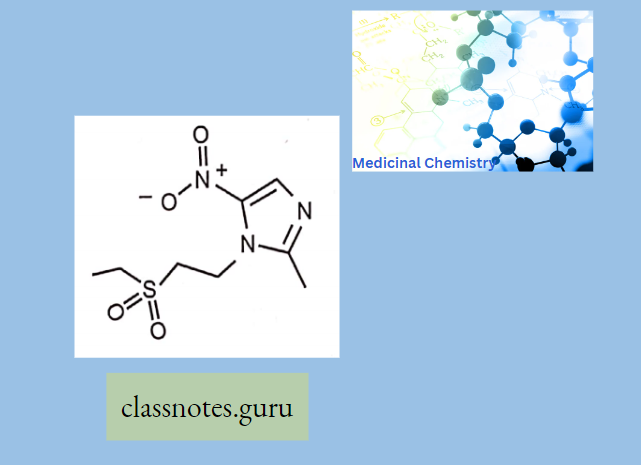
Mechanism Of Action: Tinidazole is an antiprotozoal, antibacterial agent. The nitro-group of tinidazole is reduced by cell extracts of Trichomonas. The free nitro-radical generated as a result of this reduction may be responsible for the antiprotozoal activity.
Mechanism Of Action: After passive absorption into the bacterium cells, the nitro group of imidazole is reduced to an amine group by ferredoxin-type redox systems.
Diloxanide:
Diloxanide destroys the trophozoites of E. history that eventually form into cysts. The cysts are then excreted by persons infected with asymptomatic amebiasis.
Iodoquinol:
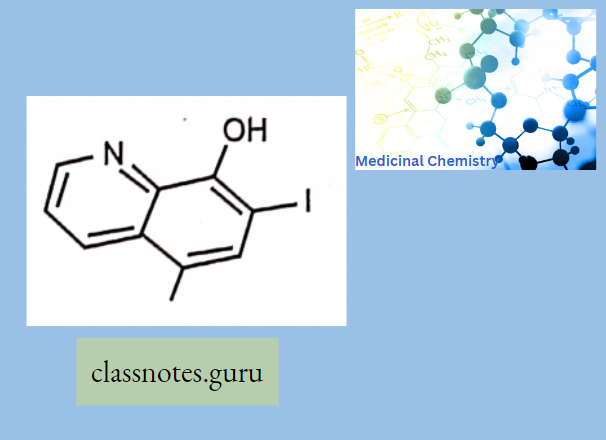
Iodoquinol is an amebocyte used against Entamoeba histolytica, and it is active against both cysts and trophozoites that are localized in the lumen of the intestine. It is considered the drug of choice for treating asymptomatic or moderate forms of amebiasis.
Atovaquone:
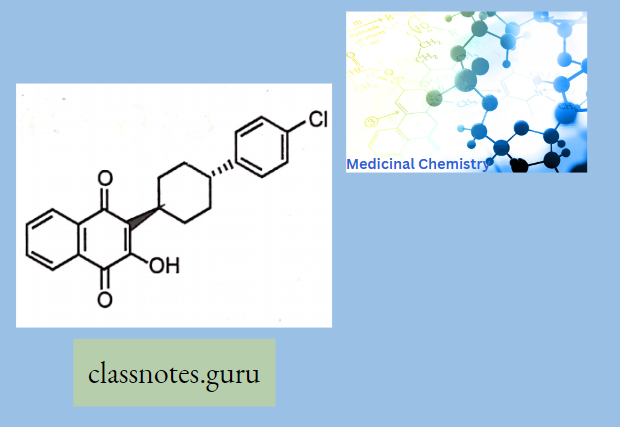
Mechanism Of Action: Atovaquone selectively inhibits the malarial cytochrome complex in the parasitic electron transport chain, collapsing the mitochondrial membrane potential. Proguanil, via its metabolite cycloguanil, functions as a dihydrofolate reductase inhibitor, halting parasitic deoxythymidine synthesis.
Eflornithine:
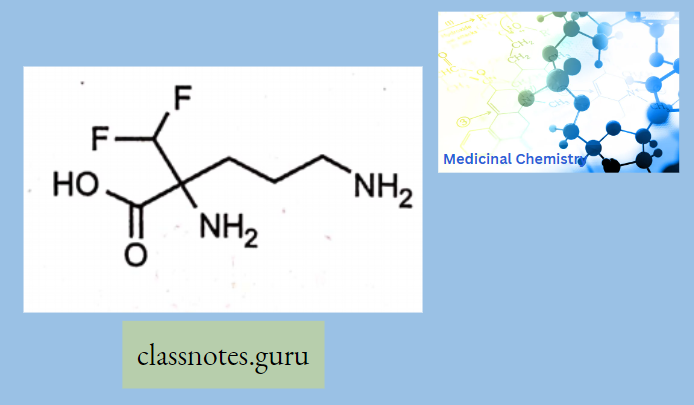
Eflomithine prevents hair growth by inhibiting the anagen phase of hair production. This occurs by eflornithine irreversibly binding (also called suicide inhibition) to ornithine decarboxylase (ODC) and physically preventing the natural substrate ornithine from accessing the active site.
Synthesis Of Metronidazole
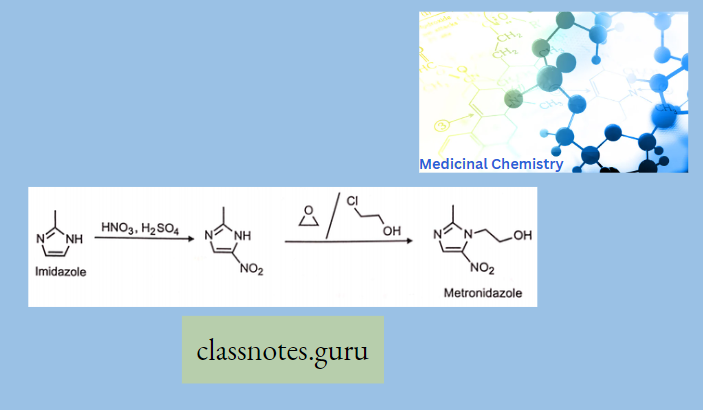
Anti Protozoal Agents Multiple Choice Question And Answers
Question 1. Isoniazid is …
- Pyridine derivative
- Trioxane derivative
- Guanidine derivative
- None
Answer: 1. Pyridine derivative
Question 2. Isoniazid act on
- Mycolic acid
- Arabino galactose
- Cox
- All
Answer: 1. Mycolic acid
Question 3. Ethambutol act on
- Mycolic acid
- Arabino galactose
- Cox
- All
Answer: 2. Arabino galactose
Question 4. Neurotoxicity is the adverse effect of…
- Isoniazid
- Ethambutol
- Both
- None
Answer: 1. Isoniazide
Question 5. Visual disruption Adverse effect of
- Isoniazid
- Pyrazinamide
- Ethambutol
- None
Answer: 3. Ethambutol
Anti Protozoal Agents Short Question And Answers
Question 1. Write the mode of action of isoniazid.
Answer:
Mode Of Action Of Isoniazid: INH inhibits Mycolase Synthase, an enzyme necessary for the biosynthesis of mycolic acid (essential constitute of mycobacterial cell wall).
Question 2. Write the mode of action of pyrazinamide.
Answer:
Mode Of Action Of Pyrazinamide: PZA enters the cell wall of M. tuberculosis via passive diffusion and it is converted to pyrazinoic acid (Active metabolite) by pyrazinamidase enzyme. Then later it inhibits mycobacterial fatty acid synthase-I enzyme and disrupts mycolic acid synthesis needed for mycobacterium cell wall synthesis.
Question 3. Write the adverse effect of Cycloserine.
Answer:
The Averse Effect Of Cycloserine
- Peripheral Neuritis
- Tremors
- Psychotic
- Behavioral changes
Question 4. Write the adverse effect of isoniazid.
Answer:
The Adverse Effect Of Isoniazid
- Peripheral Neuritis-Co administration of Pyridoxine (Vit B6) with INH prevents the symptoms of peripheral neuritis.
- GIT disturbance (Constipation, Loss of appetite)
- Hepatotoxicity
Question 5. Write the mode of action of Rifampicin.
Answer:
The Mode Of Action Of Rifampicin: It strongly binds to the (3 subunits of bacterial ‘DNA dependent RNA polymerase’ enzyme. Thereby inhibits the RNA synthesis of bacteria. Mammalian RNA polymerase does not bind to rifampicin.
Question 6. Write the adverse of Rifampicin.
Answer:
The Adverse of Rifampicin
- Hepatitis risk may increase when used in combination with INH.
- The flu-like syndrome is characterized by fever, chills, myalgias, and thrombocytopenia.
- Rifampicin imparts a harmless red-orange color to urine.
